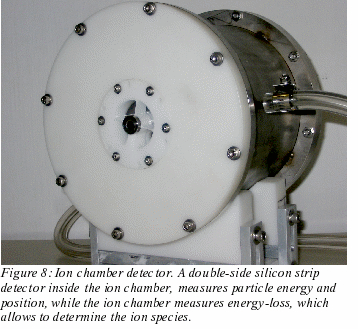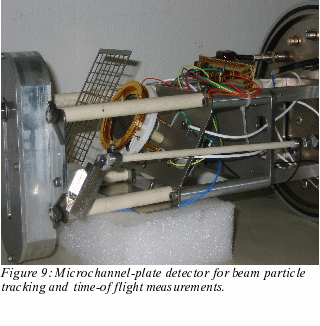The RESOLUT Facility
Dr.
Ingo Wiedenhöver, Dr. Lagy
T. Baby, E. Diffenderfer, J. Fridmann, A. Bernstein,
P.
Peplowski, A. Rojas
Florida
State University operates a superconducting linear accelerator
laboratory, which is the central facility of the
nuclear physics group and which hosts a vigorous, student-driven
research program. The group aligns its priorities to those identified
by the national Nuclear Science Advisory Committee (NSAC), which in
its most recent report recommended to build the Rare Isotope
Accelerator laboratory as its highest priority for a new facility.
This is a recognition of the importance that measuring certain
nuclear reactions has on astrophysics and gave us the motivation to
focus our research in this field and construct the RESOLUT facility
at FSU's linear accelerator laboratory. The field of nuclear
astrophysics exemplifies the connectivity of science with its
investigations being motivated by questions in astrophysics and
cosmology. Its topics range from investigations of the origin of the
chemical elements to understanding the physics of stars and
ultimately the structure of space and time in the universe.

Figure
1: RESOLUT in April 2006. The beam of stable isotopes enters from
the right, bombarding the production target, from where the reaction
products are focused into the RF resonator by means of a
superconducting solenoid magnet. The superconducting RF resonator
bunches the velocities of the reaction products, which in effect
concentrates the wanted products at the focal plane of the magnetic
spectrograph. Here, slits will select desired radioactive beam and
suppress other products. This beam of exotic isotopes is then
refocused by a second superconducting solenoid into the experiment
chamber, where its secondary reactions are measured.
Starting in 2002, we designed, proposed for
funding, built and commissioned a facility called RESOLUT (See Figure
1). RESOLUT is a novel type of rare isotope facility, which allows to
produce beams of very exotic, short-lived nuclei and thereby measure
their nuclear reactions as they occur in stars and star explosions.
The construction of RESOLUT is a major investment in the future of
this laboratory and the largest local construction project since the
linear accelerator was commissioned in1986. Dr. Wiedenhöver was
awarded the U.S. Department of Energy's “Outstanding Junior
Investigator Award”, for this project.
The
construction of RESOLUT is a group effort with heavy involvement of
the graduate students Joel Fridmann, Eric Diffenderfer and
Patrick Peplowski and, very importantly, Dr. Lagy T. Baby, who joined
the effort as a post-doctoral researcher. He has now become a staff
employee of the laboratory, in charge of the operation of RESOLUT.
Several undergraduate students participated in development projects
around RESOLUT and its detector systems. During Summer 2003, 2004 and
2005, high school students from the “Young Scholars Program”
performed research projects on cryogenic sensors for RESOLUT and
contributed to the automated cryogenic supply system used in the
facility.
RESOLUT is featured on the
title page of the June 2006 issue of “Nuclear Physics News” and
was described in a radio program of “FSU headlines” and in local
TV as a CBS local news program in spring 2004. Weighing more than 16
tons and occupying approximately 42 square meters in the laboratory
RESOLUT will be the lab's major instrumental workhorse.
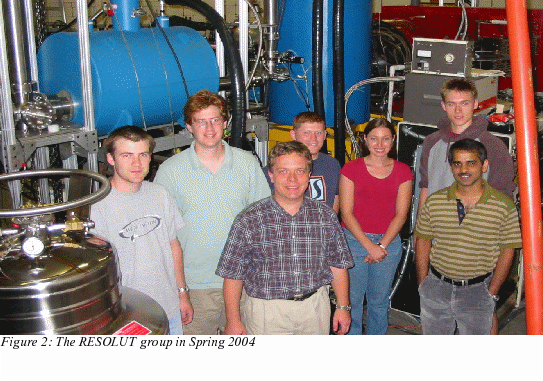
Commissioning and Initial Operation of RESOLUT.
Figure 1 shows RESOLUT facility in its completed state. We performed
a number of commissioning experiments with the facility, in various
stages of construction. The optics of the spectrograph were
calibrated during the Summer of 2004 and a first radioactive beam of
6He at an energy of 32 MeV was produced from the
11Li(d,3He) 6He reaction in the Fall
of 2004. A cooled, degraded beam was produced in April 2005, proving
the principle of operation for the superconducting RF Resonator. The
setup and control of RESOLUT is based on beam optics simulations,
which are integrated into the interactive control program.
The
biggest challenge in achieving the reliable and continuous operation
required for secondary beam experiments was found in the cryogenics
supply systems. Three components of RESOLUT are operated at liquid
Helium temperature, two 6T solenoid magnets and one superconducting
RF-resonator. One of the magnets showed excessive Helium consumption
and was returned to the manufacturer three times before it was
delivered in working condition in January 2006. Furthermore, the
existing cryogenic refrigerator proved beyond the limits of its
capacity for a continuous operation of the full linear accelerator
and RESOLUT. The cryogenic refrigerator was upgraded to a new system
with increased capacity in December 2005. The system started
operation in March 2006. The first experiment during which all
components of RESOLUT were operated continuously was performed in
April 2006.
During this experiment, we studied the reactions
of a 94.5 MeV 14C beam bombarding a thin 9Be
target. In a first run, the 9Be target was placed in the
scattering chamber of RESOLUT, where the annular ion-chamber and
Silicon detector was used to characterize the reaction products and
their energies. A particle identification spectrum from this
experiment is displayed in Figure 3. The cross sections for lighter
reaction products, such as B, Be and Li are measured relative to the
elastic scattering cross section. In a second experimental run
with the same primary beam, the 9Be target was moved to
the production target
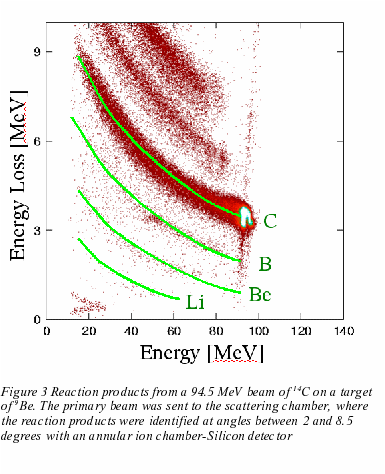
location
and the reaction products were analyzed with RESOLUT. We scanned the
reaction products by varying the spectrograph rigidity. Analysis of
this measurement will yield isotopic separation and the relative
isotopic yields throughout a wide range of the reaction products
displayed in Fig. 3. For instance, at 56 MeV, the composition of
Beryllium isotopes observed in this reaction is 1/7 12Be
and 6/7 11Be. The fact, that 12Be is produced
at all in this type of reaction comes as a solid surprise, given that
the two-body reaction Q-value is -28 MeV. The data will allow us to
investigate the mechanism for this type of deep-inelastic reaction.
A
sample spectrum of the isotopic separation achieved with RESOLUT is
displayed in Figure 4. Here, 11Be was detected centrally
in the focal plane, while the RF-resonator remained switched off. In
Figure 5 we show the same rigidity setting, with the resonator
bunching the 11Be recoils towards the 61 MeV rigidity
setting of the magnetic spectrograph. The product yield is increased
four-fold relative to the setting without the resonator. This
experiment shows, that RESOLUT can be successfully used as a
zero-degree spectrometer for recoiling nuclei with rigidities very
close to that of the primary beam. The production rate for 11Be
is at this point too low to consider secondary beam experiments,
which are mainly limited by the available primary beam intensity of
14C. However, this experiment demonstrates the use of
RESOLUT as a recoil mass spectrometer and shows the potential for a
program in the spectroscopy of light neutron-rich isotopes.
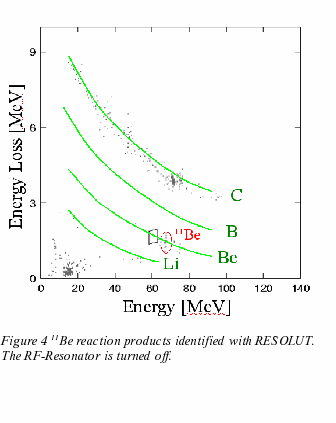
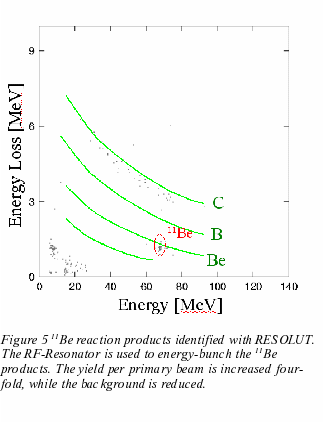
First Astrophysical Experiment
At present, the RESOLUT group is in the process of developing an 25Al
beam. The beam production is based on the reaction
at an energy of 130 MeV. The 3He target is realized as a a
thin-window gas cell, which is cooled by liquid Nitrogen in order to
increase the effective target thickness.
reaction
at an energy of 130 MeV. The 3He target is realized as a a
thin-window gas cell, which is cooled by liquid Nitrogen in order to
increase the effective target thickness.
The 25Al beam
itself is used to measure the
 proton
pickup reaction leading to excited states of 26Si. The
spectroscopy of the lowest resonances in 26Si is
addressing an important problem associated with research in γ-ray
astronomy, performed for instance with the
Integral satellite, launched in 2002 by the European Space
Agency ESA. Integral measures γ-rays
emitted from radioactive 26Al, which is used to estimate
the rate of supernova events in the galaxy. The amount of 26Al
produced in a supernova explosion is strongly dependent on the rate,
at which the lowest nuclear resonances in 26Si capture
protons, which at this point is not known and the assumed value is
based on a model calculation. We expect to provide experimental
information on this capture rate, which in turn will lead to a
refinement of the analysis of γ-ray
astronomy data.
proton
pickup reaction leading to excited states of 26Si. The
spectroscopy of the lowest resonances in 26Si is
addressing an important problem associated with research in γ-ray
astronomy, performed for instance with the
Integral satellite, launched in 2002 by the European Space
Agency ESA. Integral measures γ-rays
emitted from radioactive 26Al, which is used to estimate
the rate of supernova events in the galaxy. The amount of 26Al
produced in a supernova explosion is strongly dependent on the rate,
at which the lowest nuclear resonances in 26Si capture
protons, which at this point is not known and the assumed value is
based on a model calculation. We expect to provide experimental
information on this capture rate, which in turn will lead to a
refinement of the analysis of γ-ray
astronomy data.
RESOLUT: Principle of Operation
Although
the scientific program at RESOLUT is beginning just now, we have
reported on its concept and proposed an application as a recoil
detector for the RIA laboratory at invited talks at the RIA facility
workshop of 2005 East Lansing and as an invited talk at the Fall 2005
meeting of the American Physical Society in Chicago. RESOLUT
uses one superconducting RF-resonator synchronized in phase with the
linear accelerator, which is providing the primary beam. The
operating principle of RESOLUT is illustrated in Figures 6 and 7.
Without the RF-resonator acting (Fig. 6), RESOLUT constitutes a
large-acceptance magnetic spectrograph, creating a (mv)/q -dispersive
focal plane. For the calculation of Fig. 7, the resonator is set up
to bunch the velocities of the reaction products. This effectively
creates a mass-dispersive focal plane.
An undergraduate
student, Clifford Burchfield
developed a computer simulation of RESOLUT's ion optics with the
COSY-infinity program package. This program was used to calculate
the m/q dispersion for different ions under realistic beam
conditions. It was further refined by the graduate student P.
Peplowski and is now used to calculate the magnet and resonator
settings during the operation of RESOLUT. The simulations show that
RESOLUT constitutes a mass-spectrograph with high angular and
moderate energy acceptance. In order to investigate its usefulness as
a recoil separator for heavier beams, we calculated the separation of
isotopes around 132Sn at 5 MeV/u at the focal plane of
RESOLUT. The simulation predicts a mass resolution
of 180, based on the assumptions of ±2% energy spread
and a ±2.4°opening angle for the
recoils with a 200 ps time resolution of the initial beam.
Unlike
electrostatic mass separators, RESOLUT is optimized to be used in
inverse kinematics reactions, which makes it useful as an in-flight
radioactive beam facility as well as a recoil detector for
experiments in inverse kinematics, such as the majority of
experiments proposed for RIA.
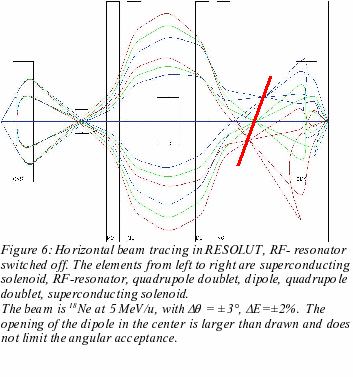
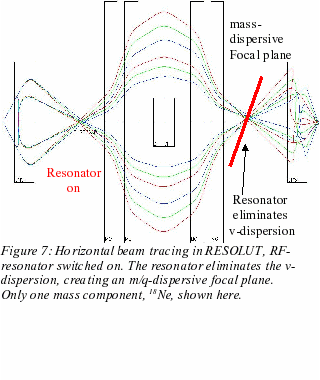
Instrument
Development
The experiments planned for and performed at RESOLUT require state of
the art particle detectors, multi-parameter data acquisition systems
and modern analysis methods. We developed a multi-strip Silicon
detector array with four annular detectors and an annular ion chamber
(Left picture in Figure 8).
An array of NaI γ-detectors
and the corresponding electronics for RESOLUT was commissioned by the
groups of Dr. R. Kaye at the Calumet campus of Purdue university on
the basis of a “Major Research Instrument” (MRI) grant for
“Research at Undergraduate Institutions”. Another grant of this
type was awarded to Dr. D. Gay at the University of North Florida in
Jacksonville, who constructed a microchannel plate detector for
tracking radioactive beams at the focal plane of RESOLUT (Right
picture in Figure 8). Both electronics and detectors were in use
during the commissioning experiments of RESOLUT and the undergraduate
students Ognjen Gabor and Sarah Dekat took part in the first
experiments using the respective systems.
